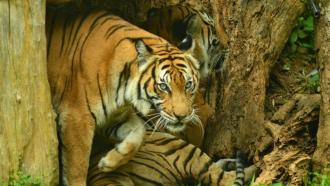Photo : Artecology Initiative
At the beginning of the performance of ‘How to be a Fig’, the choreographer Veena Basavarajaiah announced a special instruction to the audience –“view it as a talk, an amalgam of music, movement and narration with science forming the backbone”. The audience was neither dancers nor attending a dance festival, but was researchers and biodiversity conservationists attending the Student Conference on Conservation Science at the J. N. Tata Auditorium in Bangalore on 23rd of September.
But, what was the big deal about figs and watching ‘How to be a Fig’?
The relationship between the fig trees and the fig wasps is one of the most astounding one. Female fig wasps, laden with pollen from fig flowers and wasp eggs, make a one-way journey through a minute passage to enter a secret garden inside each fig. Lined with hundreds of microscopic white flowers, some become surrogates to the eggs the female wasp lays, while others fertilise and develop into seeds. Though the two partners couldn’t be more different, each depends on the other for survival. But how does one represent this intricate relationship and the complex role that fig trees play in an ecosystem through the human body?
That’s where the presentation ‘How to be a fig’ was different. Vignesh Venkateswaran, a research scholar at the Centre of Ecological Sciences, Indian Institute of Science (IISc), with his narration, introduced the secret garden inside a fig. Then, dressed in black, the performers took to the stage and transformed into figs and fig wasps for the first act.
Interspersed with Vignesh’s narration, the acts touched upon different aspects connected to figs – the female wasps entering a ripe fig to lay eggs, mating between male and female wasps, male wasps boring holes for the females to escape from the fig, and their subsequent death, the females wasps searching for a new fig and their survival, strangler figs, a wide range of animals fig trees support, like insects, hornbills, reptiles and mammals, as well as the tree’s response to natural calamities.
Conceptualized by Abhisheka Krishnagopal, an ecologist and visual artist, this project brought together people from diverse backgrounds, ranging from arts, engineering and research. They went on to keep pace with the music, even though most of them did not have any experience in movement arts prior to this. Lit by Vinay Chandra, with sound design by Shreekanth Rao, the performance was inspired by Mike Shanahan’s book, “Ladders to Heaven”. For one of the sequences, where a fig tree bows to a storm, swaying side by side and its roots traverse far and wide to ensure its outlives the storm, the music was provided by Tamara Montenegro, a sound artist from Nicaragua, Central America. The performance was executed under the aegis of Artecology Initiative – a collective of artists and ecologists.
“The intent behind such a performance was to bring in diverse people from different walks of life to understand that humans are part of the ecosystem and not separate from their natural world” said Veena. “I thank the organizers of SCCS, especially Shrék Deodhar, for the opportunity. It would be wonderful if more organizations supported experiments like these by providing platforms and financial support to integrate art and ecology” she added.
When asked about the importance of such experiments, Abhisheka remarked, “Societal involvement is extremely important to conserve nature. Unless conservation scientists reach out to non-scientific audiences it becomes an ordeal. We believe that by making arts accessible to scientists, it would become possible to communicate complex scientific concepts in a creative and engaging way”. And sure enough, the concept struck a chord with the audience, who welcomed it with a standing ovation. Stalwarts in the environmental conservation field like Dr. Ravi Chellam – distinguished wildlifer and conservation biologist, Pankaj Sekhsaria – prominent environmentalist and author, Dr. Shankar Raman - well-known wildlife scientist and writer - praised the endeavour to no end.
Dr. S. Subramanya, a celebrated ornithologist said, “It was a brilliant performance that portrayed the life of an insect and the role played by a keystone resource in nature. It was amazing to witness how expressive the medium of dance can become in narrating life and science. I honestly felt that the troupe should take their performance international”. With a debut at an internationally recognized conference, the participants look forward to showcase it at other platforms henceforth.
Members from performing and visual arts, entrepreneurs and conservation enthusiasts were also part of the audience, and they iterated the relevance of such performances in current times. “Although photography and films have been a medium for communication for years, I think very little has been explored in the front of theatre/dance to communicate scientific issues. The performance was a great mix of technical aspects of the fig tree mixed with aesthetics of the tree and the animals that depend on it”, commented Kalyan Verma, a wildlife photographer and filmmaker. “Such performances should be encouraged. I have walked away knowing a lot more about the world that I live in” stated Tejovanth N, a Bangalore-based entrepreneur.
John Muir, a famed Scottish-American naturalist and author once said, “In every walk with nature, one receives far more than he seeks”. Surely, members of the audience and the performers journeyed from ignorance to knowledge, picking up twigs from the branch of a wise old fig.






